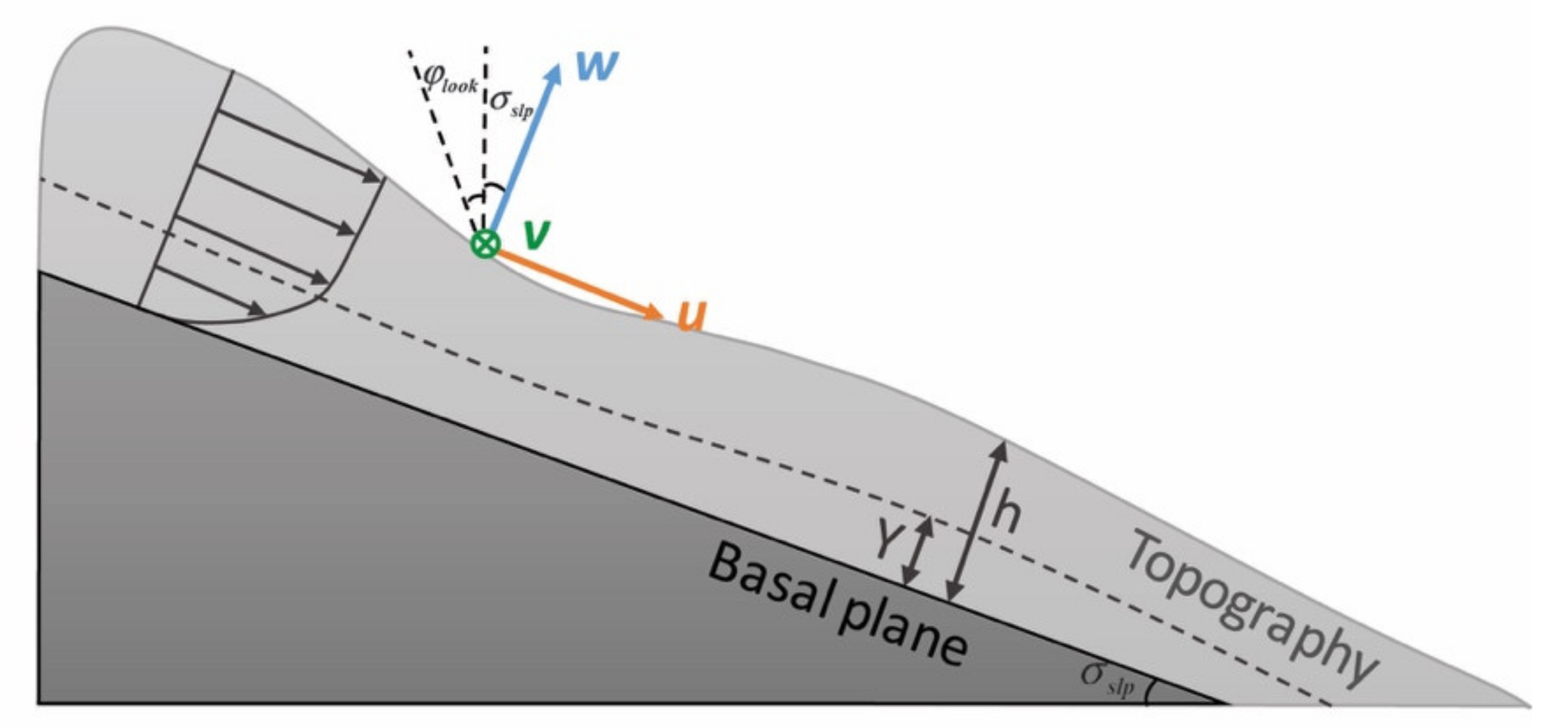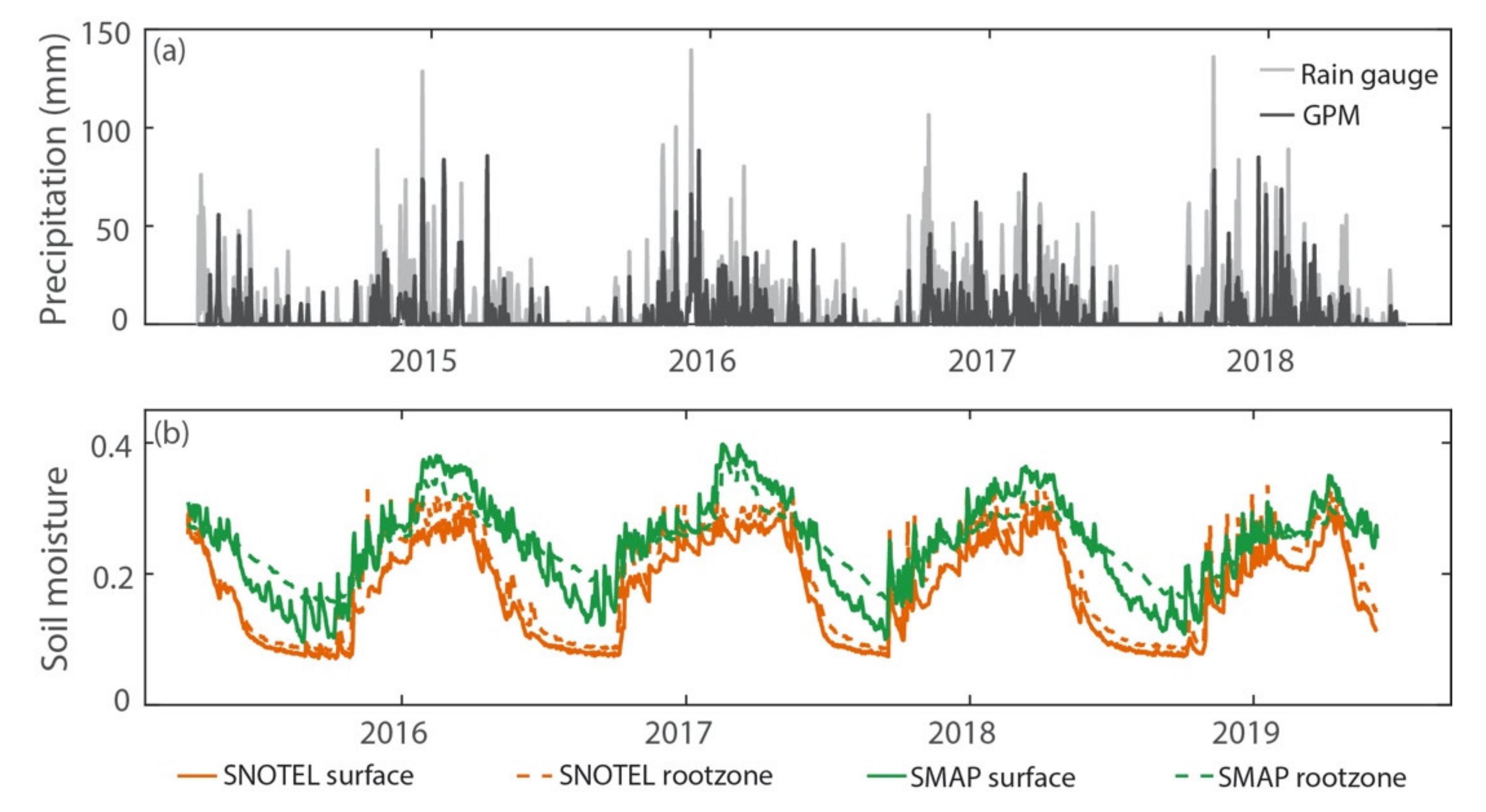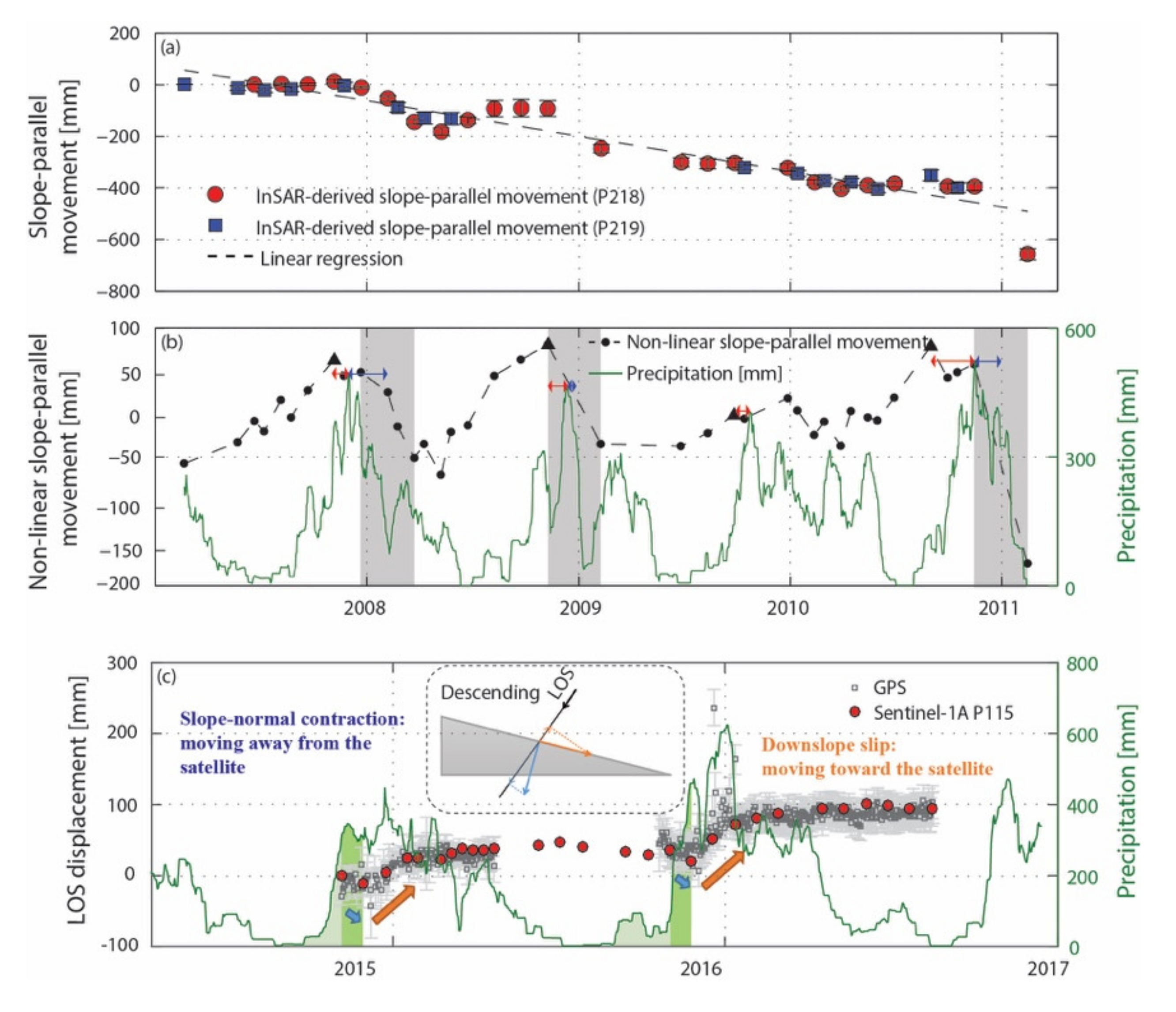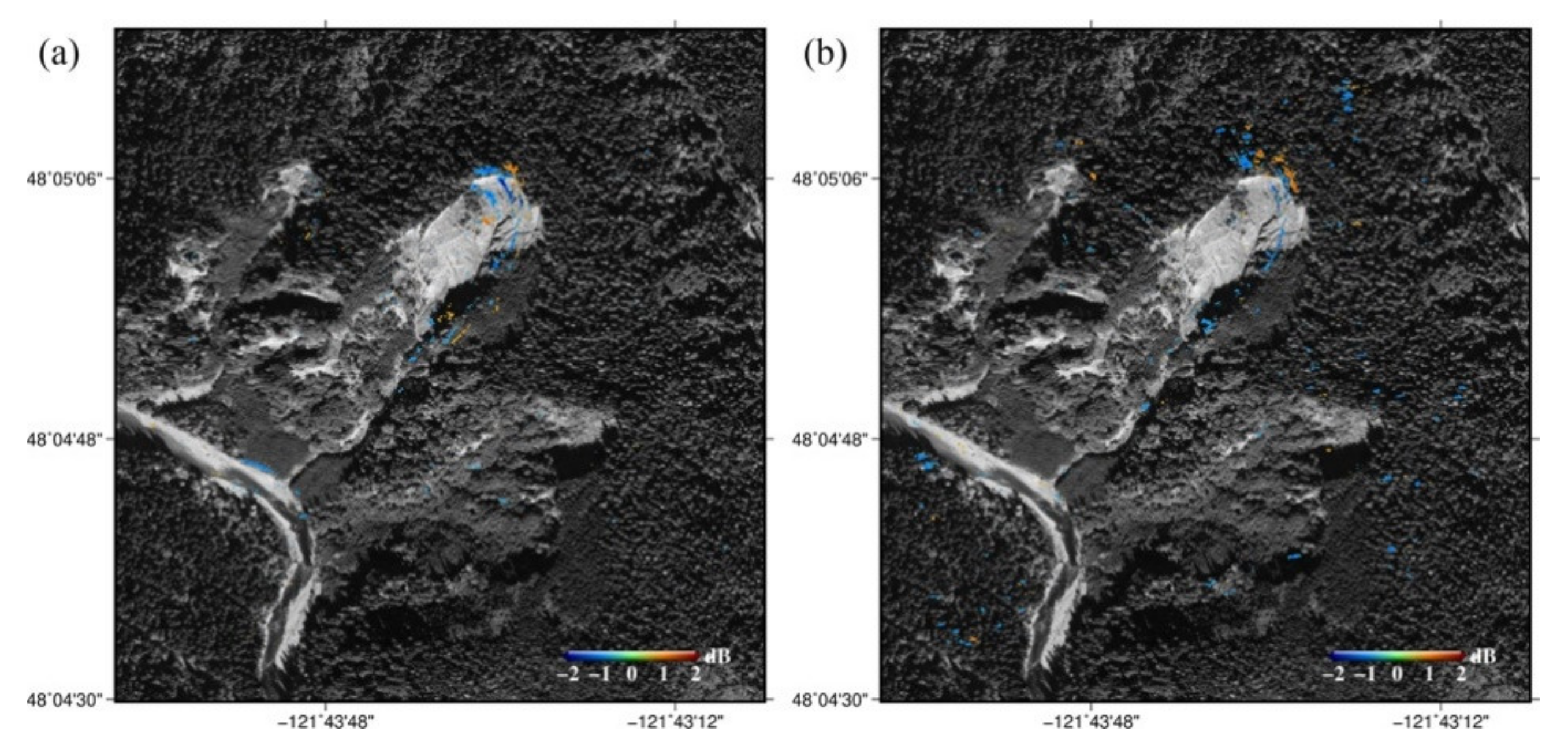A Framework for Studying Hydrology-Driven Landslide Hazards in Northwestern US Using Satellite InSAR, Precipitation and Soil Moisture Observations: Early Results and Future Directions
Abstract
:1. Introduction
2. Methodology
2.1. InSAR Methods and Offset Tracking for Mapping Landslide Movements
2.2. Mapping Landslide Runouts with Digital Elevation Model (DEM), SAR Intensity Images and InSAR Coherence Products
2.3. Precipitation Observations from Space and Ground
2.4. Soil Moisture Measurements Using SMAP
2.5. Landslide Basal Geometry and Volume from Inversion of InSAR Displacement
2.6. Understanding the Delay between Landslide Movement and Precipitation—Pore-Water Pressure Diffusion Modeling
2.7. Landslide Runout Simulation
3. Early Results
3.1. Updating Landslide Inventory with InSAR
3.2. Landslide Dynamics Inferred from InSAR: Three Case Studies
3.2.1. Cascades Landslide Complex
3.2.2. Hooskanaden Landslide
3.2.3. Gold Basin Landslide
4. Discussion
4.1. Limitations of InSAR on Landslide Monitoring
4.2. Future Developments of InSAR Studies of Landslides: Landslide Slope Stability Analysis from Physics-Based Modeling
5. Conclusions
Author Contributions
Funding
Data Availability Statement
Acknowledgments
Conflicts of Interest
References
- Cruden, D.M. A simple definition of a landslide. Bull. Eng. Geol. Environ. 1991, 43, 27–29. [Google Scholar] [CrossRef]
- Korup, O.; Densmore, A.L.; Schluengger, F. The role of landslides in mountain range evolution. Geomorphology 2010, 12, 77–90. [Google Scholar] [CrossRef]
- Larsen, I.J.; Montgomery, D.R.; Korup, O. Landslide erosion controlled by hillslope material. Nat. Geosci. 2010, 3, 247–251. [Google Scholar] [CrossRef]
- US. Geological Survey. Landslide Hazards—A National Threat. U.S. Geological Survey Fact Sheet 2005–3156; U.S. Geological Survey: Reston, VA, USA, 2005; pp. 1–2.
- Iversion, R.M. Landslide triggering by rain infiltration. Water Resour. Res. 2010, 36, 1897–1910. [Google Scholar] [CrossRef] [Green Version]
- Malamud, B.D.; Turcotte, D.L.; Guzzetti, F.; Reichenbach, P. Landslide inventories and their statistical properties. Earth Surf. Proc. Land. 2004, 29, 687–711. [Google Scholar] [CrossRef]
- Cannon, S.H.; Kirkhamb, R.M.; Parise, M. Wildfire-related debris-flow initiation processes, Storm King Mountain, Colorado. Geomorphology 2001, 39, 171–188. [Google Scholar] [CrossRef]
- Schulz, W.H.; Kean, J.W.; Wang, G. Landslide movement in southwest Colorado triggered by atmospheric tides. Nat. Geosci. 2009, 2, 863–866. [Google Scholar] [CrossRef]
- Highland, L.M.; Bobrowsky, P. The Landslide Handbook—A Guide to Understanding Landslides. In U.S. Geological Survey Circular 1325; U.S. Geological Survey: Reston, VA, USA, 2008; p. 129. [Google Scholar]
- Petley, D. Global patterns of loss of life from landslides. Geology 2012, 40, 927–930. [Google Scholar] [CrossRef]
- Iversion, R.M.; George, D.L.; Allstadt, K.; Reid, M.E.; Collins, B.D.; Vallance, J.W.; Schilling, S.P.; Godt, J.W.; Cannon, C.M.; Magirl, C.S.; et al. Landslide mobility and hazard: Implications of the 2014 Oso disaster. Earth Planet. Sci. Lett. 2015, 412, 197–208. [Google Scholar] [CrossRef] [Green Version]
- Iversion, R.M.; George, D.L. Modelling landslide liquefaction, mobility bifurcation and the dynamics of the 2014 Oso disaster. Geotechnique 2016, 66, 175–187. [Google Scholar] [CrossRef]
- Kim, J.W.; Lu, Z.; Qu, F.; Hu, X. Pre-2014 mudslides at Oso revealed by InSAR and multi-source DEM analysis. Geomat. Nat. Hazards Risk 2015, 6, 184–194. [Google Scholar] [CrossRef]
- Hilley, G.E.; Bürgmann, R.; Ferretti, A.; Novali, F.; Rocca, F. Dynamics of slow-moving landslides from Permanent Scatterer Analysis. Science 2004, 304, 1952–1954. [Google Scholar] [CrossRef] [PubMed] [Green Version]
- Mackey, B.H.; Roering, J.J. Sediment yield, spatial characteristics, and the long-term evolution of active earthflows determined from airborne LiDAR and historical aerial photographs, Eel River, California. Geol. Soc. Am. Bull. 2011, 123, 1560–1576. [Google Scholar] [CrossRef]
- Zhao, C.; Lu, Z.; Zhang, Q.; de la Fuente, J. Large-area landslide detection and monitoring with ALOS/PALSAR imagery data over Northern California and Southern Oregon, USA. Remote Sens. Environ. 2012, 124, 348–359. [Google Scholar] [CrossRef]
- Cevasco, A.; Termini, F.; Valentino, R.; Meisina, C.; Bonì, R.; Bordoni, M.; Cgekkam, G.P.; De Vita, P. Residual mechanisms and kinematics of the relict Lemeglio coastal landslide (Liguria, northwestern Italy). Geomorphology 2018, 320, 64–81. [Google Scholar] [CrossRef]
- Handwerger, A.L.; Roering, J.J.; Schmidt, D.A. Controls on the seasonal deformation of slow-moving landslides. Earth Planet. Sci. Lett. 2013, 377–378, 239–247. [Google Scholar] [CrossRef]
- Handwerger, A.L.; Rempel, A.W.; Roering, J.J.; Hilley, G.E. Rate-weakening friction characterizes both slow sliding and catastrophic failure of landslides. Proc. Natl. Acad. Sci. USA 2016, 113, 10281–10286. [Google Scholar] [CrossRef] [Green Version]
- Terzaghi, K. Mechanism of Landslides in Application of Geology to Engineering Practice; Paige, S., Ed.; Geological Society of America: New York, NY, USA, 1950; pp. 83–123. [Google Scholar]
- Warner, M.D.; Mass, C.F.; Salathé, E.P., Jr. Wintertime extreme precipitation events along the Pacific Northwest coast: Climatology and synoptic evolution. Mon. Weather Rev. 2012, 140, 2021–2043. [Google Scholar] [CrossRef] [Green Version]
- NOAA National Centers for Environmental Information (NCEI). U.S. Billion-Dollar Weather and Climate Disasters; July 2019. Available online: https://www.ncdc.noaa.gov/billions/ (accessed on 21 April 2021).
- Mastin, M.C.; Gendaszek, A.S.; Barnas, C.R. Magnitude and Extent of Flooding at Selected River Reaches in Western Washington, January 2009. In U.S. Geological Survey Scientific Investigations Report 2010–5177; U.S. Geological Survey: Reston, VA, USA, 2010; p. 34. [Google Scholar]
- Thompson, P.W.; Cierlitza, S. Identification of a Slope Failure over a Year before Final Collapse Using Multiple Monitoring Methods. In Geotechnical Instrumentation and Monitoring in Open Pit and Underground Mining; Szwedzicki, T., Ed.; A.A. Balkema: Rotterdam, The Netherlands, 1993; pp. 491–511. [Google Scholar]
- Ding, X.; Montgomery, S.B.; Tsakiri, M.; Swindells, C.F.; Jewell, R.J. Integrated Monitoring Systems for Open Pit Wall Deformation. In Meriwa Report No. 186; Australian Centre for Geomechanics: Crawley, Australia, 1998; pp. 3–114. [Google Scholar]
- Zebker, H.A.; Rosen, P.A.; Goldstein, R.M.; Gabriel, A.; Werner, C.L. On the derivation of coseismic displacement fields using differential radar interferometry: The Landers earthquake. J. Geophys. Res. 1994, 99, 19617–19634. [Google Scholar] [CrossRef]
- Massonet, D.; Briole, P.; Arnaud, A. Deflation of Mount Etna monitored by spacebrone radar interferometry. Nature 1995, 375, 567–570. [Google Scholar] [CrossRef]
- Rosen, P.A.; Hensley, S.; Joughin, I.R.; Li, F.K.; Madsen, S.N.; Rodriguez, E.; Goldstein, R. Synthetic aperture radar interferometry. Proc. IEEE 2000, 88, 333–382. [Google Scholar] [CrossRef]
- Bürgmann, R.; Rosen, P.A.; Fielding, E.J. Synthetic aperture radar interferometry to measure Earth’s surface topography and its deformation. Ann. Rev. Earth Planet. Sci. 2000, 28, 169–209. [Google Scholar] [CrossRef]
- Hanssen, R. Radar Interferometry; Kluwer: Dordrecht, The Netherlands, 2001. [Google Scholar]
- Schmidt, D.A.; Burgmann, R. Time-dependent land uplift and subsidence in the Santa Clara valley, California, from a large interferometric synthetic aperture radar data set. J. Geophys. Res. 2003, 108, 2416. [Google Scholar] [CrossRef] [Green Version]
- Simons, M.; Rosen, P.A. Interferometric synthetic aperture radar geodesy. In Treatise on Geophysics-Geodesy; Elsevier: Amsterdam, The Netherlands, 2007; Volume 3, pp. 391–446. [Google Scholar]
- Ferretti, A.; Monti-Guarnieri, A.; Prati, C.; Rocca, F.; Massonet, D. InSAR Principles-Guidelines for SAR Interferometry Processing and Interpretation; ESA: Noordwijk, The Netherlands, 2007; Volume 19. [Google Scholar]
- Lu, Z.; Dzurisin, D. InSAR Imaging of Aleutian Volcanoes: Monitoring a Volcanic Arc from Space; Springer: Berlin/Heidelberg, Germany, 2014; p. 390. [Google Scholar]
- Catani, F.; Farina, P.; Moretti, S.; Nico, G.; Strozzi, T. On the application of SAR interferometry to geomorphological studies: Estimation of landform attributes and mass movements. Geomorphology 2005, 66, 119–131. [Google Scholar] [CrossRef]
- Strozzi, T.; Farina, P.; Corsini, A.; Ambrosi, C.; Thüring, M.; Zilger, J.; Wiesmann, A.; Wegmüller, U.; Werner, C. Survey and monitoring of landslide displacements by means of L-band satellite SAR interferometry. Landslides 2005, 2, 193–201. [Google Scholar] [CrossRef]
- Farina, P.; Colombo, D.; Fumagalli, A.; Marks, F.; Moretti, S. Permanent scatterers for landslide investigations: Outcomes from the ESA-SLAM project. Eng. Geol. 2006, 88, 200–217. [Google Scholar] [CrossRef]
- Bulmer, M.H.; Petley, D.N.; Murphy, W.; Mantovani, F. Detecting slope deformation using two-pass differential interferometry: Implications for landslide studies on Earth and other planetary bodies. J. Geophys. Res. Planets 2006, 111, E06S16. [Google Scholar] [CrossRef] [Green Version]
- Pierson, T.; Lu, Z. InSAR Detection of Renewed Movement of a Large Ancient Landslide in the Columbia River Gorge, Washington. In Proceedings of the From Volcanoes to Vineyards: Living with Dynamic Landscapes, Geological Society of America 2009 Annual Meeting, Portland, OR, USA, 18–21 October 2009; p. 497. [Google Scholar]
- Calabro, M.D.; Schmidt, D.A.; Roering, J.J. An examination of seasonal deformation at the Portuguese Bend landslide, southern California, using radar interferometry. J. Geophys. Res. Earth Surf. 2010, 115, F02020. [Google Scholar] [CrossRef]
- Cascini, L.; Fornaro, G.; Peduto, D. Advanced low- and full-resolution DInSAR map generation for slow-moving landslide analysis at different scales. Eng. Geol. 2010, 112, 29–42. [Google Scholar] [CrossRef]
- Hu, X.; Wang, T.; Pierson, T.C.; Lu, Z.; Kim, J.; Cecere, T.H. Detecting seasonal landslide movement within the Cascade landslide complex (Washington) using time-series SAR imagery. Remote Sens. Environ. 2016, 187, 49–61. [Google Scholar] [CrossRef] [Green Version]
- Schlögel, R.; Doubre, C.; Malet, J.P.; Masson, F. Landslide deformation monitoring with ALOS/PALSAR imagery: A D-InSAR geomorphological interpretation method. Geomorphology 2015, 231, 314–330. [Google Scholar] [CrossRef]
- Dong, J.; Zhang, L.; Liao, M.; Gong, J. Improved correction of seasonal tropospheric delay in InSAR observations for landslide deformation monitoring. Remote Sens. Environ. 2019, 233, 111370. [Google Scholar] [CrossRef]
- Colesanti, C.; Ferretti, A.; Prati, C.; Rocca, F. Monitoring landslides and tectonic motions with the permanent scatterers technique. Eng. Geol. 2003, 68, 3–14. [Google Scholar] [CrossRef]
- Hu, X.; Lu, Z.; Pierson, T.; Kramer, R.; George, D. Combining InSAR and GPS to determine transient movement and thickness of a seasonally active low-gradient translational landslide. Geophys. Res. Lett. 2018, 45, 1453–1462. [Google Scholar] [CrossRef]
- Berardino, P.; Fornaro, G.; Lanari, R.; Sansosti, E. A new algorithm for surface deformation monitoring based on small baseline differential SAR interferograms. IEEE Trans. Geosci. Remote Sens. 2002, 40, 2375–2383. [Google Scholar] [CrossRef] [Green Version]
- Ferretti, A.; Prati, C.; Rocca, F. Permanent scatterers in SAR interferometry. IEEE Trans. Geosci. Remote Sens. 2001, 39, 8–20. [Google Scholar] [CrossRef]
- Hooper, A.; Zebker, H.; Segall, P.; Kampes, B. A new method for measuring deformation on volcanoes and other natural terrains using InSAR persistent scatterers. Geophys. Res. Lett. 2004, 31, L23611. [Google Scholar] [CrossRef]
- Wang, T.; Jónsson, S. Improved SAR Amplitude Image Offset Measurements for Deriving Three-Dimensional Coseismic Displacements. IEEE J. Sel. Top. Appl. Earth Observ. Remote Sens. 2015, 8, 3271–3278. [Google Scholar] [CrossRef] [Green Version]
- Hu, X.; Wang, T.; Liao, M. Measuring coseismic displacements with point-like targets offset tracking. IEEE Geosci. Remote Sens. Lett. 2014, 11, 283–287. [Google Scholar] [CrossRef]
- Moro, M.; Chini, M.; Saroli, M.; Atzori, S.; Stramondo, S.; Salvi, S. Analysis of large, seismically induced gravitational deformations imaged by high resolution COSMO-SkyMed SAR. Geology 2011, 39, 527–530. [Google Scholar] [CrossRef]
- Kim, J.W.; Lu, Z.; Gutenberg, L.; Zhu, Z. Characterizing hydrologic changes of the Great Dismal Swamp using SAR/InSAR. Remote Sens. Environ. 2017, 198, 187–202. [Google Scholar] [CrossRef]
- Melo, R.; Asch, T.V.; Zêzere, J.L. Debris flow run-out simulation and analysis using a dynamic model. Nat. Hazards Earth Syst. Sci. 2018, 18, 555–570. [Google Scholar] [CrossRef] [Green Version]
- Napoli, M.D.; Martire, D.D.; Bausilio, G.B.; Calcaterra, D.; Confuorto, P.; Firpo, M.; Pepe, G.; Cevasco, A. Rainfall-Induced Shallow Landslide Detachment, Transit and Runout Susceptibility Mapping by Integrating Machine Learning Techniques and GIS-Based Approaches. Water 2021, 13, 488. [Google Scholar] [CrossRef]
- Kavoura, K.; Sabatakakis, N. Investigating landslide susceptibility procedures in Greece. Landslides 2020, 17, 127–145. [Google Scholar] [CrossRef]
- Xu, Y.K.; George, D.L.; Kim, J.W.; Lu, Z.; Riley, M.; Griffin, T.; de la Fuente, J. Landslide monitoring and runout hazard assessment by integrating multi-source remote sensing and numerical models: An application to the Gold Basin landslide complex, northern Washington. Landslides 2020, 18, 1131–1141. [Google Scholar] [CrossRef]
- Wasowski, J.; Bovenga, F. Remote Sensing of Landslide Motion with Emphasis on Satellite Multitemporal Interferometry Applications. In An Overview, Landslide Hazards, Risks and Disasters; Elsevier: Amsterdam, The Netherlands, 2014; pp. 345–403. [Google Scholar]
- Hooper, A. A multi-temporal InSAR method incorporating both persistent scatterer and small baseline approaches. Geophys. Res. Lett. 2008, 35, L16302. [Google Scholar] [CrossRef] [Green Version]
- Liu, Y.Y.; Lu, Z.; Zhao, C.Y.; Kim, J.W.; Zhang, Q.; de la Fuente, J. Characterization of the Kinematic Behavior of Three Bears Landslide in Northern California using L-band InSAR Observations. Remote Sens. 2019, 11, 2726. [Google Scholar] [CrossRef] [Green Version]
- Casu, F.; Manconi, A.; Pepe, A.; Lanari, R. Deformation time-series generation in areas characterized by large displacement dynamics: The SAR amplitude pixel-offset SBAS technique. IEEE Trans. Geosci. Remote Sens. 2011, 49, 2752–2763. [Google Scholar] [CrossRef]
- McKean, J.; Roering, J. Objective landslide detection and surface morphology mapping using high-resolution airborne laser altimetry. Geomorphology 2004, 57, 331–351. [Google Scholar] [CrossRef]
- Glenn, N.F.; Streutker, D.R.; Chadwick, D.J.; Thackray, G.D.; Dorsch, S.J. Analysis of LiDAR-derived topographic information for characterizing and differentiating landslide morphology and activity. Geomorphology 2006, 73, 131–148. [Google Scholar] [CrossRef]
- Hong, Y.; Adler, R.; Huffman, G. Evaluation of the potential of NASA multi-satellite precipitation analysis in global landslide hazard assessment. Geophys. Res. Lett. 2006, 33, L22402. [Google Scholar] [CrossRef]
- NASA. SMAP (Soil Moisture Active Passive) Handbook: Mapping Soil Moisture and Freeze/Thaw from Space; Jet Propulsion Laboratory Publication: Pasadena, CA, USA, 2014; pp. 1–192.
- Lu, Z.; Kim, J.; Hu, X.; Xu, Y.; George, D. Development of an Incorporated Platform to Characterize Hydrology-Driven Landslide Hazards in Northwestern US. In Proceedings of the Asia Oceania Geosciences Society 15th Annual Meeting, Honolulu, HI, USA, 3–8 June 2018. [Google Scholar]
- Xu, Y.; Kim, J.W.; George, D.L.; Lu, Z. Seasonal rainfall-driven sliding, basal geometry, and time lag from InSAR: Lawson Creek landslide, Oregon. Remote Sens. 2019, 11, 2347. [Google Scholar] [CrossRef] [Green Version]
- Okada, Y. Surface deformation due to shear and tensile faults in a half space. Bull. Seismol. Soc. Am. 1985, 75, 1135–1154. [Google Scholar]
- Aryal, A.; Benjamin, A.B.; Reid, M.E. Landslide subsurface slip geometry inferred from 3-D surface displacement fields. Geophys. Res. Lett. 2015, 42, 1411–1417. [Google Scholar] [CrossRef]
- Nikolaeva, E.; Walter, T.R.; Shirzaei, M.; Zschau, J. Landslide observation and volume estimation in central Georgia based on L-band InSAR. Nat. Hazards Earth Syst. Sci. 2014, 14, 675–688. [Google Scholar] [CrossRef] [Green Version]
- Booth, A.M.; Lamb, M.P.; Avouac, J.P.; Delacourt, C. Landslide velocity, thickness, and rheology from remote sensing: La Clapière landslide, France. Geophys. Res. Lett. 2013, 40, 1–6. [Google Scholar] [CrossRef] [Green Version]
- Delbridge, B.; Burgmann, R.; Fielding, E.; Hensley, S. Kinematics of the Slumgullion Landslide from UAVSAR Derived Interferograms. In Proceedings of the 2015 IEEE International Geoscience and Remote Sensing Symposium (IGARSS), Milan, Italy, 26–31 July 2015; IEEE: Piscataway, NJ, USA, 2015; pp. 3842–3845. [Google Scholar]
- Reid, M.E. A pore-pressure diffusion model for estimating landslide-inducing rainfall. J. Geol. 1994, 102, 709–717. [Google Scholar] [CrossRef]
- Boggard, T.A.; Greco, R. Landslide hydrology: From hydrology to pore pressure. WIREs Water 2016, 3, 439–459. [Google Scholar] [CrossRef]
- Hu, X.; Bürgmann, R.; Lu, Z.; Handwerger, A.L.; Wang, T.; Miao, R.Z. Mobility, thickness, and hydraulic diffusivity of the slow-moving Monroe landslide in California revealed by L-band satellite radar interferometry. J. Geophys. Res. 2019, 124, 7504–7518. [Google Scholar] [CrossRef] [Green Version]
- Kang, Y.; Lu, Z.; Zhao, C.Y.; Xu, Y.K.; Kim, J.W.; Gallegos, A.J. InSAR Monitoring of Creeping Landslides in Mountainous Regions: A Case Study in Eldorado National Forest, California. Remote Sens. Environ. 2021, 258, 112400. [Google Scholar] [CrossRef]
- George, D.L.; Iversion, R.M. A depth-averaged debris-flow model that includes the effects of evolving dilatancy: 2. Numerical predictions and experimental tests. Proc. R. Soc. A 2014, 470, 2170. [Google Scholar] [CrossRef] [Green Version]
- Orr, E.L.; Orr, W.N. Oregon Geology, 6th ed.; Oregon State University Press: Corvalis, OR, USA, 2012. [Google Scholar]
- Cheney, E.S. Chapter 3: Overview of the Geology of Washington in the Geology of Washington and Beyond; University of Washington Press: Seattle, WA, USA, 2015; pp. 18–20. [Google Scholar]
- Wieczorek, G.F. Preparing a detailed landslide-inventory map for hazard evaluation and reduction. Environ. Eng. Geosci. 1984, XXI, 337–342. [Google Scholar] [CrossRef]
- Bonì, R.; Bordoni, M.; Colombo, A.; Lanteri, L.; Meisina, C. Landslide state of activity maps by combining multi-temporal A-DInSAR (LAMBDA). Remote Sens. Environ. 2018, 217, 172–190. [Google Scholar] [CrossRef]
- Stanley, T.A.; Kirschbaum, D.B. Effects of inventory bias on landslide susceptibility calculation. In Proceedings of the 3rd North American Symposium on Landslides, Roanoke, VA, USA, 4–8 June 2017. [Google Scholar]
- Xu, Y.; Lu, Z.; Schulz, W.H.; Kim, J.W. Twelve-year dynamics and rainfall thresholds for alternating creep and rapid movement of the Hooskanaden landslide from integrating InSAR, pixel offset tracking, and borehole and hydrological measurements. J. Geophys. Res. Earth Surf. 2020, 125, e2020JF005640. [Google Scholar] [CrossRef]
- Randall, J.R. Characterization of the Red Bluff Landslide, Greater Cascade Landslide Complex, Columbia River Gorge, Washington. Master’s Thesis, Portland State University, Portland, OR, USA, 2012. [Google Scholar]
- Peter, H.; Jäggi, A.; Fernández, J.; Escobar, D.; Ayuga, F.; Arnold, D.; Wermuth, M.; Hackel, S.; Otten, M.; Simmons, W.; et al. Sentinel-1A—First precise orbit determination results. Adv. Space Res. 2018, 60, 879–892. [Google Scholar] [CrossRef]
- Booth, A.M.; Roering, J.J.; Perron, J.T. Automated landslide mapping using spectral analysis and high-resolution topographic data: Puget Sound lowlands, Washington, and Portland Hills, Oregon. Geomorphology 2009, 109, 132–147. [Google Scholar] [CrossRef]
- Handwerger, A.L.; Fielding, E.J.; Huang, M.-H.; Bennett, G.L.; Liang, C.; Schulz, W.H. Widespread initiation, reactivation, and acceleration of landslides in the northern California Coast Ranges due to extreme rainfall. J. Geophys. Res. Solid Earth 2019, 24, 1782–1797. [Google Scholar] [CrossRef] [Green Version]
- Ferretti, A.; Fumagalli, A.; Novali, F.; Prati, C.; Rocca, F.; Rucci, A. A new algorithm for processing interferometric data-stacks: SqueeSAR. IEEE Trans. Geosci. Remote Sens. 2011, 49, 3460–3470. [Google Scholar] [CrossRef]
- Fornaro, G.; Verde, S.; Reale, D.; Pauciullo, A. CAESAR: An approach based on covariance matrix decomposition to improve multibaseline- multitemporal interferometric SAR processing. IEEE Trans. Geosci. Remote Sens. 2015, 53, 2050–2065. [Google Scholar] [CrossRef]
- Davies, T. Hazards and Disaster Series: Landslide Hazards, Risks, and Disasters; Academic Press: Cambridge, MA, USA, 2015. [Google Scholar]
- Abramson, L.W.; Boyce, G.M.; Thomas, S.; Sharma, S. Slope Stability and Stabilization Methods, 2nd ed.; Wiley: New York, NY, USA, 2002. [Google Scholar]










Publisher’s Note: MDPI stays neutral with regard to jurisdictional claims in published maps and institutional affiliations. |
© 2021 by the authors. Licensee MDPI, Basel, Switzerland. This article is an open access article distributed under the terms and conditions of the Creative Commons Attribution (CC BY) license (https://creativecommons.org/licenses/by/4.0/).
Share and Cite
Lu, Z.; Kim, J. A Framework for Studying Hydrology-Driven Landslide Hazards in Northwestern US Using Satellite InSAR, Precipitation and Soil Moisture Observations: Early Results and Future Directions. GeoHazards 2021, 2, 17-40. https://doi.org/10.3390/geohazards2020002
Lu Z, Kim J. A Framework for Studying Hydrology-Driven Landslide Hazards in Northwestern US Using Satellite InSAR, Precipitation and Soil Moisture Observations: Early Results and Future Directions. GeoHazards. 2021; 2(2):17-40. https://doi.org/10.3390/geohazards2020002
Chicago/Turabian StyleLu, Zhong, and Jinwoo Kim. 2021. "A Framework for Studying Hydrology-Driven Landslide Hazards in Northwestern US Using Satellite InSAR, Precipitation and Soil Moisture Observations: Early Results and Future Directions" GeoHazards 2, no. 2: 17-40. https://doi.org/10.3390/geohazards2020002





